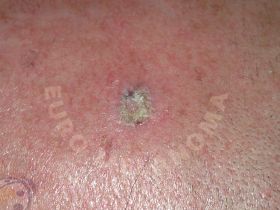Actinic keratosis
Lees meer over een ander soort kanker
Actinic keratosis AK is a very common type of skin lesion. It is generally pre-cancerous but, if left untreated, can develop into squamous cell carcinomas.
The lesions are pre-cancerous; in 10 – 15% of cases they may develop into squamous cell carcinomas, so they should be treated to prevent progression. This occurs most commonly in middle-aged and elderly people, on areas most exposed to the sun such as the face, neck, ears, back of the hands and scalp. It presents as red-brown scaly and rough patches of skin.

How to recognize it?
AKs can appear either on their own or in patches. They typically look like small (usually 1-2cm), crusty patches of skin and can be flesh-toned, red, white, pink, or a combination of colours. Some lesions can be very small, or virtually invisible, but can be identified by their rough texture. AK can have a negative impact on quality of life as lesions can cause cosmetic discomfort.
Both visible and non-visible AKs can be a sign of further lesions beneath the skin, any of which could develop into squamous cell carcinomas. Therefore, it is important to seek treatment, regardless of the lesions size or appearance.
Where can it appear?
AKs can occur anywhere on the body but are most often found in more sun-exposed areas, such as the face, neck, ears, chest, hands, limbs and scalp.
What is the treatment?
Single lesions are often frozen with liquid nitrogen and cases of multiple lesions can be treated locally with medical creams that either; stimulate the local immune response, make the cancerous cells sensitive to light, or contain chemotherapy drugs.

To watch this video you need to accept third-party cookies (Marketing).
If you cannot view the video, please click here
Do you want to watch other AK stories?
If you want to know more about actinic keratosis, you can find additional testimonials showcasing the importance of prevention and early diagnosis of the disease.












